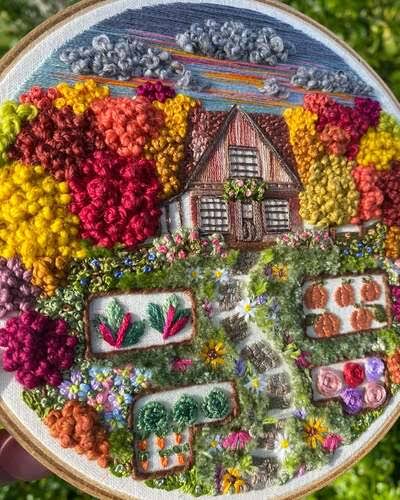Are you looking for a creative, low-maintenance way to bring color, texture, and artistry into your home or garden decor? Then it’s time to transform your garden with embroidered flowers! These beautiful handmade creations can mimic the charm of real blooms while adding a touch of timeless elegance to your outdoor or indoor space. Whether you’re a seasoned crafter or a beginner, embroidered flowers offer a unique way to showcase your personality and creativity.In this guide, we’ll explore everything you need to know about embroidered flowers, from materials and techniques to creative display ideas that can turn your garden into a vibrant, artistic haven.🌷 Introduction: The Art of Embroidered FlowersEmbroidery has been used for centuries as a decorative art form, but when applied to floral designs, it takes on a whole new level of beauty. These handcrafted blooms can be displayed in frames, sewn onto garden fabrics, or even turned into art pieces for outdoor areas.You don’t need a green thumb to enjoy flowers all year round — just a few simple stitches and some creativity! With this guide, you’ll learn how to transform your garden with embroidered flowers and enjoy their lasting beauty without worrying about watering, sunlight, or weather changes.🧵 Why Choose Embroidered Flowers for Garden Decor?Embroidered flowers bring elegance and creativity to any space. Here are a few reasons why they’re perfect for your garden or patio area:1. They Last ForeverUnlike real flowers that fade over time, embroidered blooms keep their color and shape indefinitely.2. They Add Artistic ValueEach piece of embroidery is unique — your handmade flowers reflect your creativity and can’t be replicated.3. They’re Weather-FriendlyIf displayed under a shaded patio or protected space, embroidered flowers won’t wilt or require maintenance.4. They Make Perfect GiftsNothing says “thoughtful” like a handcrafted embroidered flower bouquet or framed floral art piece.So, whether you’re decorating a cozy garden nook, balcony, or conservatory, transform your garden with embroidered flowers and enjoy everlasting beauty.🌸 Materials You’ll NeedBefore you start stitching, gather these basic supplies:Embroidery hoop (wood or plastic)Fabric (cotton, linen, or canvas)Embroidery floss in various floral colorsNeedles (embroidery or crewel type)ScissorsEmbroidery pattern or a simple flower sketchOptional: Beads, sequins, or metallic threads for extra sparkle🪡 Step-by-Step: How to Create Embroidered FlowersStep 1: Choose Your Flower DesignStart with simple flowers like daisies, sunflowers, or roses. You can find free embroidery patterns online or sketch your own.Step 2: Prepare the FabricStretch your chosen fabric tightly in the embroidery hoop. Make sure it’s smooth and firm.Step 3: Transfer the DesignLightly trace your flower pattern onto the fabric using a water-soluble pen or pencil.Step 4: Select Your StitchesHere are some classic embroidery stitches perfect for floral designs:Satin stitch: Great for filling in petals and leaves.French knots: Perfect for flower centers or pollen.Stem stitch: Ideal for stems and outlines.Lazy daisy stitch: Creates lovely petal shapes.Step 5: Stitch Your FlowersBegin stitching slowly, following the outlines and filling in the petals. Combine different shades of thread to create depth and realism.Step 6: Add DetailsUse beads, metallic threads, or sequins to make your embroidered flowers sparkle in the light.Step 7: Finish and FrameOnce you’re done, gently wash off any pen marks and let your embroidery dry. Then, frame it or attach it to fabric panels for garden decor.🌼 Creative Ways to Display Embroidered FlowersReady to transform your garden with embroidered flowers? Here are some stunning display ideas:1. Framed Floral ArtHang embroidered flower art pieces on garden walls, fences, or patios. Use weather-resistant frames for outdoor display.2. Embroidered Plant PotsWrap embroidered fabric around clay or plastic pots for a charming, handmade touch.3. Garden BannersSew multiple embroidered flowers onto a fabric banner and hang it between two trees or garden posts.4. Decorative CushionsAdd embroidered floral designs to your garden seating cushions for a cozy, personalized look.5. Wall Hangings or HoopsLeave your embroidery in its hoop and hang it directly as wall art — simple yet stylish!🌺 Pro Tips for Perfect Floral EmbroideryStart simple: Begin with one flower type and a few stitches before trying complex designs.Use high-quality floss: It makes colors richer and prevents tangling.Play with textures: Mix matte and shiny threads for dimension.Layer your stitches: Create depth by overlapping petals slightly.Protect your work: If displaying outdoors, seal your finished embroidery with a fabric protector spray.🌻 The Therapeutic Joy of EmbroideryEmbroidery isn’t just about creating beautiful art — it’s also a relaxing, mindful activity. Stitching each petal helps you slow down, focus, and relieve stress. Many people find it as calming as gardening itself!When you transform your garden with embroidered flowers, you’re not only beautifying your space but also nurturing your creativity and inner peace.🌹 Bonus Idea: Combine Real and Embroidered FlowersBlend both natural and handmade beauty by pairing embroidered flower art with real plants. Frame your embroidery near potted flowers that match your stitched designs — it creates a stunning, cohesive garden aesthetic.For instance:Pair embroidered sunflowers with live sunflowers for a radiant summer vibe.Combine stitched lavender sprigs with real lavender for a fragrant, artistic corner.This creative mix brings your embroidery to life and adds a whimsical charm to your outdoor space.🌼 Conclusion: Create Beauty That LastsNature’s beauty is fleeting — but with embroidery, you can preserve its charm forever. Whether you display your work indoors or outside, embroidered flowers will brighten your surroundings with handmade elegance.So why wait? Gather your materials, thread your needle, and transform your garden with embroidered flowers! It’s a fun, creative, and rewarding way to celebrate nature through art — one stitch at a time.

